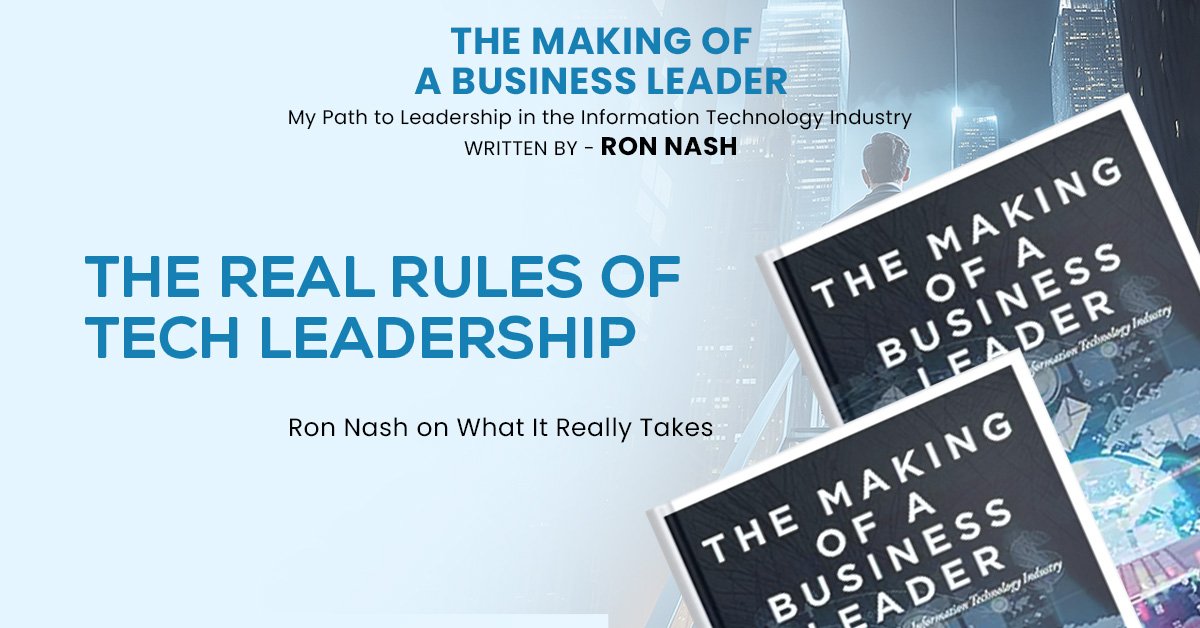There’s no shortage of leadership advice floating around—TED Talks, blog posts, LinkedIn mantras. But when it comes to thriving in the intense, ever-evolving world of the information technology industry, very few speak from real trenches.
Ron Nash does.
In his book, The Making of a Business Leader, Nash shares hard-won truths about becoming a leader in one of the most demanding and high-stakes environments imaginable. Forget the clichés—this is leadership without filters. And it’s precisely what rising professionals need to hear.
Leadership Isn’t a Title. It’s a Series of Choices.
The first myth Nash dispels is the idea that leadership is something handed to you once you’ve climbed high enough. In the fast-paced world of IT, that thinking is dangerous. In fact, it’s fatal.
Leadership, as Nash frames it, is a mindset—a daily discipline that shows up in how you think, speak, decide, and deal with stress. It begins before you have power and continues long after you do. His advice? Stop chasing positions. Start mastering presence.
From his earliest days in the industry, Nash understood one thing: how you show up when no one is watching defines who you’ll become when everyone is.
The Art of Staying Calm in the Chaos
Information technology is relentless. New tools, new threats, new competitors—it’s an environment built for the agile and the aware. In such a volatile landscape, Nash emphasizes emotional control as a critical skill.
He recounts moments where calm leadership—not just technical skill—was the difference between a crisis and a breakthrough. The lesson? You don’t need to be the loudest voice in the room. You need to be the clearest.
Tech companies rise and fall based on their ability to manage uncertainty. Nash teaches readers how to lead from the eye of the storm—not the edges of it.
Decision-Making in the Digital Age
As Nash points out, tech leaders are often faced with decisions that involve massive risk and incomplete information. What he offers is not a formula, but a mindset—one rooted in curiosity, analysis, and humility.
In one standout chapter, he breaks down the anatomy of a critical business decision he faced as CEO. What makes it powerful isn’t the outcome—it’s the process: listening to the right people, knowing when data matters and when instincts take over, and never allowing ego to cloud judgment.
In the IT world, leaders don’t just execute—they navigate. And Nash’s navigation skills are on full display in this book.
Working With, Not Over, Smart People
The tech industry is full of talent. Engineers, developers, analysts, creatives. Nash makes it clear: if you’re threatened by smart people, you shouldn’t be a leader.
He built his career by doing the opposite—surrounding himself with brilliant minds and finding ways to unify them. His message is simple but powerful: “You don’t need to be the smartest in the room. You need to create a room where everyone gets smarter.”
This collaborative philosophy is especially crucial in IT, where innovation is a team sport and ego kills ideas faster than failure.
A Playbook for the Mentally Tough
Ultimately, The Making of a Business Leader isn’t about quick wins. It’s about lasting presence. Nash shares the internal game of leadership—the resilience it takes to face rejection, the discipline it takes to make unpopular decisions, and the vision it takes to lead people into uncertain futures.
He doesn’t sugarcoat it. He doesn’t pretend it’s easy. And that’s exactly why this book matters.
A Final Word
If you want a glossy tale of overnight success, this book isn’t for you.
But if you want real, applicable insight from someone who led through decades of industry evolution—who built companies, made mistakes, and came out wiser—you won’t find a more grounded or useful guide.
Ron Nash isn’t preaching. He’s mentoring. And The Making of a Business Leader is your invitation to listen.
Amazon link: The Making of a Business Leader










Leave a Reply